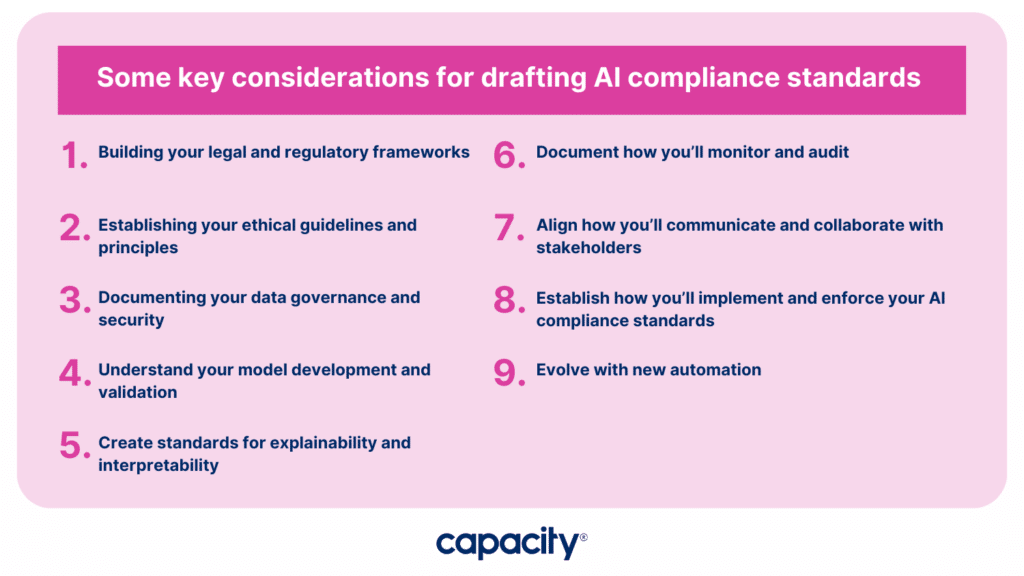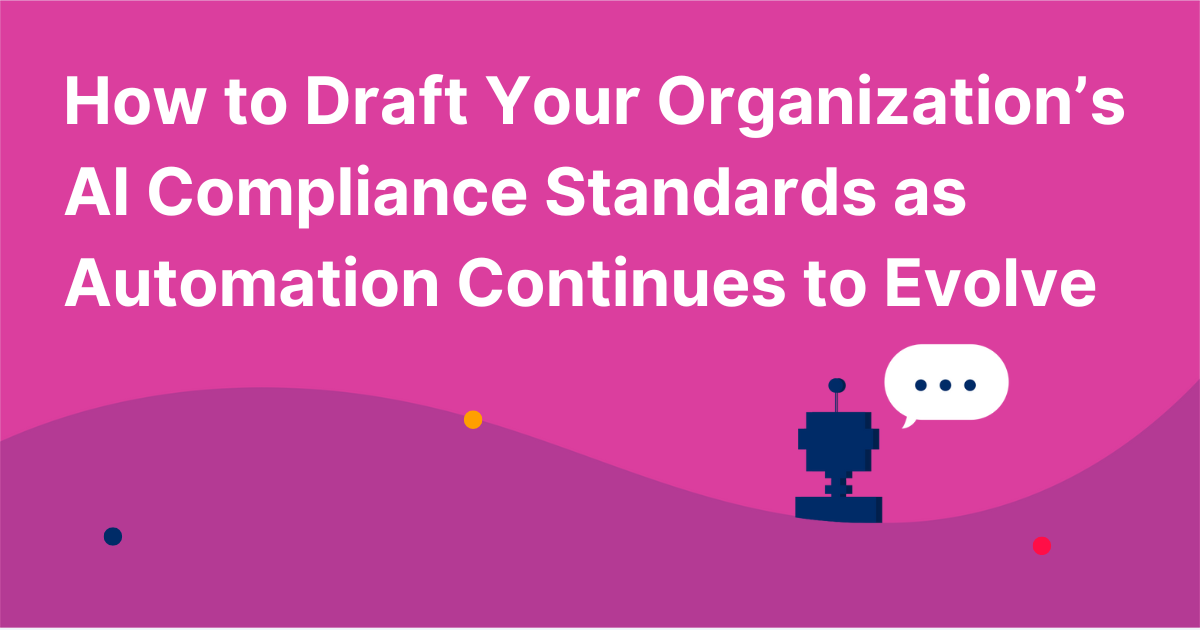AI is becoming increasingly complex and pervasive, amplifying the significance of AI compliance. These compliance standards serve as a crucial framework. They ensure your AI systems operate within the bounds of ethical, legal, and societal norms. They’re designed to mitigate risks, promote transparency, and safeguard against biases and discrepancies in AI decision-making.
As such, drafting your organization’s AI compliance standards in response to ongoing advancements in automation is more than a regulatory requirement. It’s a strategic imperative for the responsible and effective integration of AI technologies. This becomes your roadmap to navigate the potential challenges and align with the changing legal landscape,\. What’s more, it helps you to foster trust in AI among all stakeholders.
Understanding AI compliance
AI compliance refers to the adherence and conformity of AI systems to legal, ethical, and regulatory frameworks. It ensures AI is developed, implemented, and operated in a manner that meets applicable guidelines, laws, and industry standards. And it helps address potential risks associated with AI, like bias, privacy infringement, and unfair decision-making. Knowing that technology like ChatGPT had a million users in the first five days, standards are vital to public trust.
The impact of automation on compliance requirements is significant, as it introduces new complexities and challenges. Automated AI systems can process vast amounts of data and make decisions at high speeds, making it difficult for traditional compliance processes to keep up. A survey from MIT Sloan Management found that 87% of global organizations think AI will give them a competitive edge. AI may require businesses to review and adapt compliance frameworks to incorporate specific algorithmic fairness, explainability, data protection, and security considerations. Automation also necessitates ongoing monitoring and auditing of AI systems to ensure continued regulation compliance. Your business must proactively address these challenges to navigate the evolving landscape of AI compliance effectively.
Some key considerations for drafting AI compliance standards

Building your legal and regulatory frameworks
Building legal and regulatory frameworks when drafting AI compliance is important for several reasons. Firstly, understanding applicable laws and regulations regarding AI ensures compliance and avoids legal challenges. Secondly, it helps identify potential legal risks and liabilities associated with AI, enabling organizations to mitigate them proactively. Lastly, ensuring compliance with data protection and privacy laws is crucial, considering the reliance of AI systems on personal data. Developing robust legal frameworks ensures responsible and ethical AI implementation, reduces legal liabilities, and builds trust among users and stakeholders.
Establishing your ethical guidelines and principles
Establishing ethical guidelines and principles when drafting AI compliance is essential to ensure that the systems we create and use work in a manner that is fair, unbiased and respects the rights and dignity of all individuals. Artificial intelligence systems have the potential to influence nearly every aspect of our lives, from healthcare to education, from employment to social interactions. However, AI systems can perpetuate and amplify existing biases and discriminatory practices without appropriate ethical standards, leading to unfair outcomes and infringing upon individuals’ rights. For instance, if an AI system is trained on biased data, it could lead to discriminatory hiring practices or unequal access to resources or opportunities.
Incorporating ethical considerations into AI compliance standards promotes transparency, fairness, and accountability. Transparency is key to understanding how AI systems make decisions, which is crucial for holding them accountable. For example, if an AI system’s decision-making process is not transparent, it may be challenging to determine if it has made a mistake or acted unfairly. Fairness ensures that AI systems treat all individuals and groups equitably, avoiding favoritism or discrimination. On the other hand, accountability ensures that there are mechanisms in place to take responsibility when AI systems cause harm or violate ethical standards. Together, these principles serve as a guide for creating AI systems that respect human dignity and rights, ensuring their responsible and beneficial use in society.
Documenting your data governance and security
Robust data governance practices ensure data quality and consistency, which are key for reliable AI outputs. The security and integrity of AI training data are vital to prevent breaches and the potential misuse of AI systems. Any compromise in data can result in incorrect AI predictions. Furthermore, protecting sensitive information and user privacy is necessary to maintain user trust and avoid legal issues. Good data governance and security measures ensure responsible and ethical AI use.
Understand your model development and validation
Adding best practices for model development and deployment ensures quality and mitigates risks. Rigorous testing and validation of AI algorithms are necessary to detect and correct errors or biases. And this thenprevents potential harm or injustice. Moreover, continual monitoring and evaluation of model performance and accuracy are essential to maintain AI systems’ efficiency, identify performance deviations over time, and make necessary adjustments. Understanding and properly handling model development and validation processes are key to creating trustworthy, fair, and robust AI systems.
Create standards for explainability and interpretability
Creating standards for explainability and interpretability is essential when drafting AI compliance, as these standards ensure transparency and accountability in AI systems. They facilitate the ability to explain AI decision-making processes, enabling your stakeholders and regulators to understand how outcomes are derived. Ensuring transparency also promotes accountability as it allows for scrutiny of the AI systems’ decisions, making rectifying any erroneous or unfair outcomes possible. Documenting model behavior and providing justifications for outcomes helps identify and understand any bias or discrepancies and establish remedial measures if needed. Therefore, standards for explainability and interpretability form a cornerstone of ethical, reliable, and transparent AI systems.
Document how you’ll monitor and audit
Documenting how you’ll monitor and audit ensures the continual evaluation of AI systems to maintain their integrity and efficacy. Ongoing monitoring helps observe your system’s behavior in real-time, thus providing opportunities for timely interventions if needed. Regular audits are crucial to assess whether the AI systems comply with the established guidelines and regulations and detect anomalies. These audits also facilitate identifying and addressing deviations or risks, preventing or mitigating potential harm or system failures.
Align how you’ll communicate and collaborate with stakeholders
Aligning how you’ll communicate and collaborate with stakeholders is pivotal to ensuring the standards’ inclusivity, comprehensiveness, and effective implementation. Involving relevant stakeholders in the drafting process ensures that all perspectives are considered, promoting comprehensive and robust compliance rules. Encouraging cross-functional collaboration and expertise sharing enables the blending of diverse skills and knowledge, resulting in an enriched and well-rounded AI compliance framework. Moreover, actively seeking feedback and input from diverse teams such as legal, IT, ethics, and compliance ensures that all legal, technological, ethical, and regulatory aspects are covered adequately. In essence, transparent communication and active stakeholder collaboration are fundamental to creating and implementing effective, inclusive, and reliable AI compliance standards.
Establish how you’ll implement and enforce your AI compliance standards
Defining roles and responsibilities for compliance oversight assigns accountability, ensuring that individuals or teams enforce compliance and maintain the standards. Establishing mechanisms for reporting and resolving compliance issues enables your organization to effectively handle potential breaches, swiftly correcting deviations and preventing harm. Employee training and awareness programs are also critical, as they equip them with the knowledge and skills necessary to understand and adhere to AI compliance standards. Therefore, clearly outlining the implementation and enforcement procedures ensures a consistent and robust approach to AI compliance, fostering responsible and ethical AI practices.
Evolve with new automation
The field of AI is dynamic. There are constant technological advancements and changes in societal needs and regulatory landscapes. As such, it’s important to update and revise your AI compliance standards to stay relevant and effective. Adapting compliance standards to align with evolving regulatory requirements ensures legal compliance and helps mitigate the risks of legal repercussions. A forward-looking and adaptive approach toward AI compliance lets you remain ethical, responsible, and legal.
With the right AI compliance standards, you can navigate the potential challenges of automation, align your organization with the changing legal landscape, and foster trust in your AI applications. So, as AI reshapes the future, let it not be a journey into the unknown. Instead, let your organization’s AI compliance standards serve as a well-crafted roadmap, guiding you toward a responsible, transparent, and efficient integration of AI technologies into your operations.

Automate Your Work
Capacity’s enterprise AI chatbot can help:
- Answer FAQs anytime, anywhere
- Find relevant documents within seconds
- Give surveys and collect feedback














































